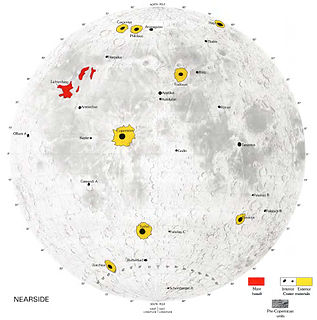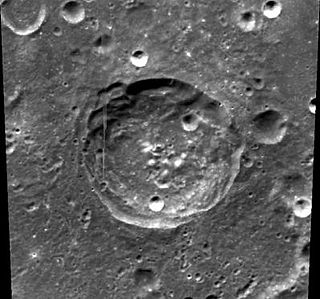 Lunar Orbiter 4 image | |
| Coordinates | 72°06′N32°24′W / 72.1°N 32.4°W Coordinates: 72°06′N32°24′W / 72.1°N 32.4°W |
|---|---|
| Diameter | 70 km |
| Depth | 3.4 km |
| Colongitude | 30° at sunrise |
| Eponym | Philolaus |

Philolaus is a lunar impact crater that is located in the northern part of the Moon's near side. It lies within one crater diameter to the east-southeast of the flooded crater Anaximenes, and to the west of the smaller Anaxagoras. It overlies the older and heavily worn Philolaus C to the south.

Lunar craters are impact craters on Earth's Moon. The Moon's surface has many craters, almost all of which were formed by impacts.

An impact crater is an approximately circular depression in the surface of a planet, moon, or other solid body in the Solar System or elsewhere, formed by the hypervelocity impact of a smaller body. In contrast to volcanic craters, which result from explosion or internal collapse, impact craters typically have raised rims and floors that are lower in elevation than the surrounding terrain. Impact craters range from small, simple, bowl-shaped depressions to large, complex, multi-ringed impact basins. Meteor Crater is a well-known example of a small impact crater on Earth.

Earth's Moon is an astronomical body that orbits the planet and acts as its only permanent natural satellite. It is the fifth-largest satellite in the Solar System, and the largest among planetary satellites relative to the size of the planet that it orbits. The Moon is, after Jupiter's satellite Io, the second-densest satellite in the Solar System among those whose densities are known.
Contents
This crater retains a well-defined form that has not changed significantly since it was originally created. The outer rim edge is roughly circular, but with a somewhat irregular edge that displays signs of slumping. The most notable slump is a triangular area along the eastern rim. The inner wall of the crater has a complex system of terraces with a sharp-edged rim in locations where slumping has occurred. On the exterior of the rim is an outer rampart that extends outwards for nearly half a crater diameter in all directions. The crater has a ray system, and is consequently mapped as part of the Copernican System. [1]

A ray system comprises radial streaks of fine ejecta thrown out during the formation of an impact crater, looking somewhat like many thin spokes coming from the hub of a wheel. The rays may extend for lengths up to several times the diameter of their originating crater, and are often accompanied by small secondary craters formed by larger chunks of ejecta. Ray systems have been identified on the Moon, Earth, Mercury, and some moons of the outer planets. Originally it was thought that they existed only on planets or moons lacking an atmosphere, but more recently they have been identified on Mars in infrared images taken from orbit by 2001 Mars Odyssey's thermal imager.

The Copernican Period in the lunar geologic timescale runs from approximately 1.1 billion years ago to the present day. The base of the Copernican period is defined by impact craters that possess bright optically immature ray systems. The crater Copernicus is a prominent example of rayed crater, but it does not mark the base of the Copernican period.
The interior floor is irregular with rough areas about the center and to the northeast. There is no single central peak, but rather a pair of peaks offset to the south and the east of the middle. There is also a smaller ridge pair offset to the northwest. The flattest part of the interior floor is in the northeast of the crater interior. The floor is not significantly marked by impacts.






















